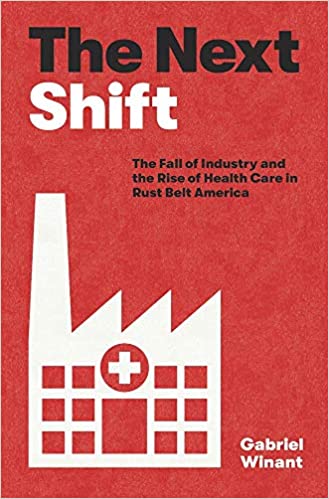You have /5 articles left.
Sign up for a free account or log in.
 The Next Shift: The Fall of Industry and the Rise of Health Care in Rust Belt America by Gabriel Winant
The Next Shift: The Fall of Industry and the Rise of Health Care in Rust Belt America by Gabriel Winant
Harvard University Press, Published in March 2021
When we talk about the new economy, we tend to talk about tech. The reality is that the technology sector employs a relatively small number of people.
Where the action is is in eds and meds.
Thirty-four million people work in education or health-care services. The next-largest category, wholesale and retail trade, employees around 20 million.
The health-care industry is almost unimaginably huge in the US. Nearly one in five dollars spent for all goods and services goes to health care.
When we say that we've transitioned from a manufacturing to a service economy, we are talking about health care and education.
No city personifies the shift from manufacturing to services more than Pittsburgh.
Once dominated by steel manufacturing, today the two largest employers in Pittsburgh are health care/insurance companies.
Pittsburgh is the prototypical eds and meds town. The football team shouldn't be called the Steelers, but the Bedpans. (Or the MRIs, or more accurately, the Nurses.)
How did this transition from manufacturing to services, steel to health care, happen in Pittsburgh?
And what can the rest of the country learn about the benefits and costs to communities and workers when the employment base changes from making things to caring for (and educating) people?
In The Next Shift, U of Chicago historian Gabriel Winant has written the definitive account of the causes and consequences of the decline of heavy industry and the birth of the medical-industrial complex.
Winant dives deeply into Pittsburgh's economic, social and cultural history to illuminate the linkages between the rise and fall of steel and the spectacular growth of health care.
I had not fully understood until reading The Next Shift how deeply entangled deindustrialization and medical growth have been. The rise of the mammoth university-affiliated medical center and the erosion of manufacturing jobs were tightly coupled.
Steelworkers became the new highly lucrative hospital patients -- aging, unhealthy, but well insured (thanks to the unions) as medical care became more intensive.
Hospital systems expanded on the twin foundations of insurance (private and public) and a primarily low-wage labor force. The caring that was once done in the home in the single-earner industrial economy moved to the hospital, with caregivers filling essential but insecure and low-paying positions.
The Next Shift is essential reading for anyone wanting to understand our modern health-care industry's historical and economic foundations.
The book also got me curious about the employment distribution within higher education. How much of the postsecondary workforce is made up of low-wage workers?
What would he have found if Winant had expanded his analysis in Pittsburgh beyond the hospital and nursing home sector to include colleges and universities?
Readers interested in economic change, urban history, race, class, gender, steel, health care and Pittsburgh should put The Next Shift on their reading list.
What are you reading?








